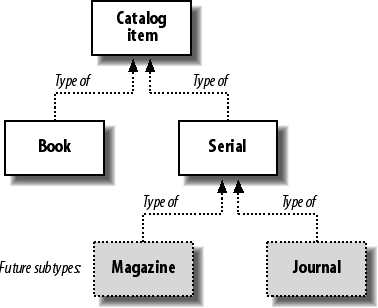Object Types by Example
In keeping with the sample general application area explored in the introductory book, Learning Oracle PL/SQL Programming (O’Reilly), I’d like to build an Oracle system that will use an object-oriented approach to modeling a trivial library catalog. The catalog can hold books, serials (such as magazines, proceedings, or newspapers), and, eventually, other artifacts.
A graphic portrayal of the top-level types appears in Figure 26-1. Later on, I might want to add to the type hierarchy, as the dotted-line boxes imply.

Figure 26-1. Type hierarchy for a trivial library catalog
Creating a Base Type
The “root” or top of the hierarchy represents the common characteristics of all the subtypes. For now, let’s assume that the only things that books and serials have in common are a library-assigned identification number and some kind of filing title. I can create an object type for catalog items using the following SQL statement from SQL*Plus:
CREATE OR REPLACE TYPE catalog_item_t AS OBJECT (
id INTEGER,
title VARCHAR2(4000),
NOT INSTANTIABLE MEMBER FUNCTION ck_digit_okay
RETURN BOOLEAN,
MEMBER FUNCTION print
RETURN VARCHAR2
) NOT INSTANTIABLE NOT FINAL;This statement creates an object type, which is similar to a Java or C++ class. In relational terms, an object type is akin to a record type bundled with related functions and procedures. These subprograms are known collectively ...
Get Oracle PL/SQL Programming, 5th Edition now with the O’Reilly learning platform.
O’Reilly members experience books, live events, courses curated by job role, and more from O’Reilly and nearly 200 top publishers.

